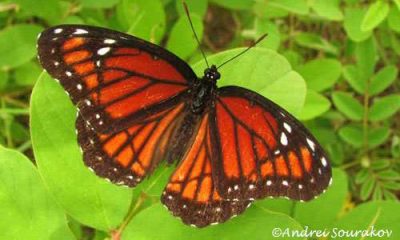The Viceroy butterfly, Limenitis archippus is similar to but smaller than the monarch butterfly.

Viceroy butterflies live in most of the continental United States, southern Canada and northern Mexico.
The wing span of the adult ranges from 2.5 to 3.375 inches. The viceroy is a very distinct butterfly for its genus, but can be confused with monarchs, queens, and soldiers which it mimics in different parts of its range.
The eggs are laid singly on the tips of leaves and resemble galls. The first instar larvae hatch in approximately five days. They make perches by feeding on the leaf tips, but they leave the central vein intact. The third instar viceroy larva feeds on willow leaves and will complete its development in three weeks. There may be two to three broods per year.

Adult viceroys prefer wet habitats such as ponds, swamps and rivers where willow, aspen and poplars trees are found. Males will actively perch in the late mornings and early afternoons, looking for females and defending their territories. Viceroy adults sip nectar from flowers in the aster family, and they also feed on fungi and carrion.
The viceroy butterfly looks very similar to the monarch butterfly and it uses a defense mechanism called “mimicry” to escape predators.
Because the monarch butterfly eats milkweed as a caterpillar, it produces a chemical in its body which is extremely poisonous and distasteful to most animals. The monarch butterfly’s bright orange color advertises this to predators and tells them to stay away.
Viceroy butterflies feed on poplar and willow leaves as caterpillars. They do not eat milkweed as caterpillars so they are not poisonous yet predators do NOT eat them.
How can you tell the difference between the monarch and the viceroy? First, look at their bottom two wings. The viceroy has a thick, black line crossing the black veins of the hindwings whereas the monarch doesn’t have the crossing black line.

Next, look at their size. The monarch is slightly larger than the viceroy. The viceroy is only 2.5” to 3.5” wide while the monarch is 3.5 to 4”. Their flight patterns are also quite different. The viceroy flies more erratically and faster whereas the monarch slowly drifts and floats through the air.